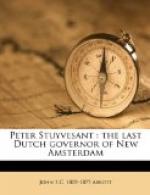“On the east side there rises a large level field, of about one hundred and sixty acres, through which runs a very fine fresh stream; so that land can be ploughed without much clearing. It appears to be good. The six farms, four of which lie along the river Hell-gate, stretching to the south side of the island, have at least one hundred and twenty acres to be sown with winter seed, which, at the most, may have been ploughed eight times.”
There were eighteen families at Fort Orange, which was situated on Tawalsoutha creek, on the west side of the Hudson river, about thirty-six Dutch miles above the island of Manhattan. These colonists built themselves huts of bark, and lived on terms of cordial friendship with the Indians. Wassenaar writes, “The Indians were as quiet as lambs, and came and traded with all the freedom imaginable.”
The Puritans had now been five years at Plymouth. So little were they acquainted with the geography of the country that they supposed New England to be an island.[1] Floating rumors had reached them of the Dutch colony at the mouth of the Hudson. Governor Bradford commissioned Mr. Winslow to visit the Dutch, who had sent a ship to Narragansett bay to trade, that he might dissuade them from encroaching in their trade upon territory which the Puritans considered as exclusively belonging to them. Mr. Winslow failed to meet the Dutch before their vessel had sailed on its return to Manhattan.
Soon after this the Dutch Governor, Peter Minuit, sent secretary De Rassieres to Governor Bradford, with a very friendly letter, congratulating the Plymouth colony upon its prosperity, inviting to commercial relations, and offering to supply their English neighbors with any commodities which they might want.
Governor Bradford, in his reply, very cordially reciprocated these friendly greetings. Gracefully he alluded to the hospitality with which the exiled Pilgrims had been received in Holland. “Many of us,” he wrote,
“are tied by the good and courteous entreaty which we have found in your country, having lived there many years with freedom and good content, as many of our friends do this day; for which we are bound to be thankful, and our children after us, and shall never forget the same.”
At the same time he claimed that the territory, north of forty degrees of latitude, which included a large part of New Netherland, and all their Hudson river possessions, belonged to the English. Still he promised that, for the sake of good neighborhood, the English would not molest the Dutch at the mouth of the Hudson, if they would “forbear to trade with the natives in this bay and river of Narragansett and Sowames, which is, as it were, at our doors.”
The authorities at Fort Amsterdam could not, for a moment, admit this claim of English supremacy over New Netherland. Director Minuit returned an answer, remarkable for its courteous tone, but in which he firmly maintained the right of the Dutch to trade with the Narragansetts as they had done for years, adding “As the English claim authority under the king of England, so we derive ours from the States of Holland, and we shall defend it.”




